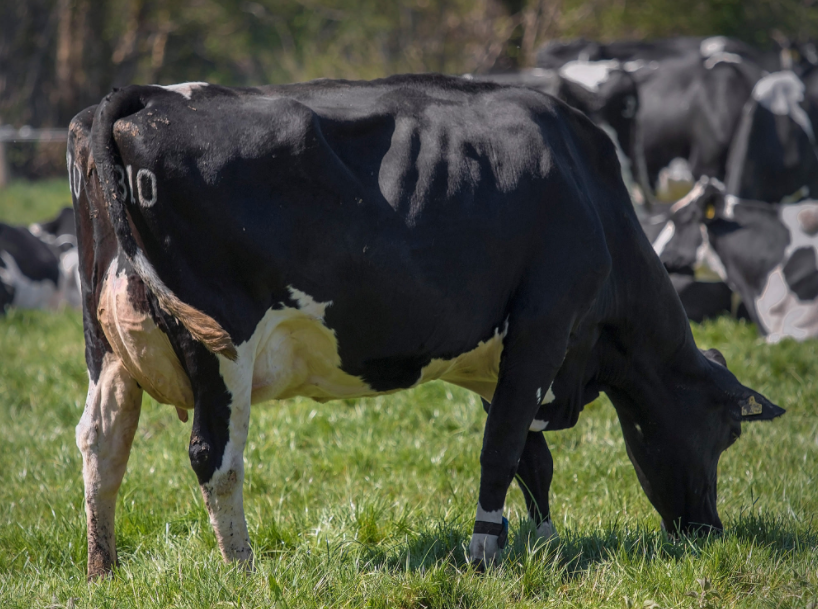What is Heat Stress?
Heat stress is when cattle fail to control their body temperature and it starts to rise. A cow’s body temperature needs to remain a constant 38.8 oC (± 0.5 oC). To maintain this, the heat generated from normal rumen digestion and metabolism must be lost to the environment. However, when the environmental temperature is high, this heat is lost more slowly, causing the cow’s body temperature to rise resulting in heat stress.
Dairy cows are particularly prone to heat stress because rumen digestion of feed generates a lot of heat. Higher yielding cows eat more and generate more heat than lower yielding cows and therefore, are at more risk of heat stress. In addition, older cows are less able to deal with heat stress compared to younger cows.
A cow’s comfort zone (known as the thermoneutral zone), has an upper limit of 25oC and at temperatures above this, the cow is at risk of heat stress. The amount of heat stress that a cow experiences is a combination of temperature and humidity. Using the latest Northern Irish weather conditions (temperatures up to 30oC with humidity reaching 60%) and inputting it into tables produced from studies, cows are at a significant risk of moderate to severe heat stress right now.
What are the signs of Heat Stress?
Compared to other animals, cattle cannot dissipate their heat very effectively. As cows try to increase heat loss and maintain their normal body temperature, they increase their breathing rate, may hold their head low and stretched out, pant, sweat and drool. They become sluggish, inactive and spend more time standing.
What are the implications of Heat Stress?
As most of the heat production in cows is due to rumen fermentation, cows will reduce their intakes to limit heat production. With intakes decreased, there can be detrimental impacts on milk production, reproductive performance, and immune function. As they spend more time standing, this can put pressure on their feet, resulting in lameness.
What can be done to help?
In the present conditions, it is key that we try to alleviate the heat stress that cows experience to support milk production, reproductive performance, and immune function. There are a few environmental and nutritional management recommendations to help ease the effects of this heat.
Environment management
There are several techniques to cool the environment and get air moving, to help cattle lose heat: –
- Allowing cows access to shade such as housing, to escape the direct sun.
- Keep cow movement to a minimum during the heat of the day.
- Try to keep the time when cows are gathered in the collecting yard to a minimum.
- Fans get air moving to help cool the surrounding area and dissipate heat. This is especially useful in areas where cows are gathered such as collecting yards.
- Sprinklers or hoses can be used in collecting yards to cool cows waiting to be milked. One downside is that wetting cows may increase the moisture in lying areas and increase the risk for environmental mastitis.
Dietary management
Water intake increases during hot weather and providing plenty of cool, clean water is critical, especially before and after milking. There are two factors to consider
- The number of drinkers. This is important as cows are unlikely to walk more than 250 meters to drink. Although this may seem like something that cannot be easily or quickly changed, some farmers have redirected water pipes across the hedge from drinkers in other fields and plumbed them into spare drinkers.
- Flow rate. If cows are queueing around water drinkers, this is a sign that the flow rate is insufficient for the herd of cows. Milking cows typically require more than 100 litres of water per day and will drink between 2 and 6 times a day. In hot weather, water intakes can increase 10 – 20%. If cows are queuing around water drinkers, tanks can be filled at times of lower demand to give to cows at peak demand, especially around milking time.
Certain dietary changed can help reduce the amount of heat generated in the rumen
- High quality forages produce less heat through rumen fermentation compared to low quality ‘stemy’ forages.
- Offering higher levels of concentrates support intakes and help cows maintain their energy requirements, especially when intakes are lower. This will also limit heat production as concentrates generate less heat by fermentation than forages.
- As rumen protected fats are energy dense, incorporating them into the diet can help the cow meet energy requirements when intakes are lower.
- Dietary buffers and yeasts can protect against rumen acidosis, helping to offset the reduction in salivary bicarbonate due to reduced intakes, reduced cud chewing and losses through drooling.
- The mineral content of rations can be reviewed so that the minerals lost in sweat, such as sodium, potassium and magnesium, are adequately replaced in the diet.
With any change in the diet, care must be taken so they are properly balanced to avoid digestive upsets such as acidosis and your Smyths Daleside nutritionist can help with dietary changes.
Summary
The current weather conditions are placing cows in moderate to severe risk of heat stress. However, there are some management and dietary changes that can be made to help limit the detrimental impacts of heat stress and maintain productivity. Your Smyths Daleside nutritionist can help with any advice and dietary changes.
